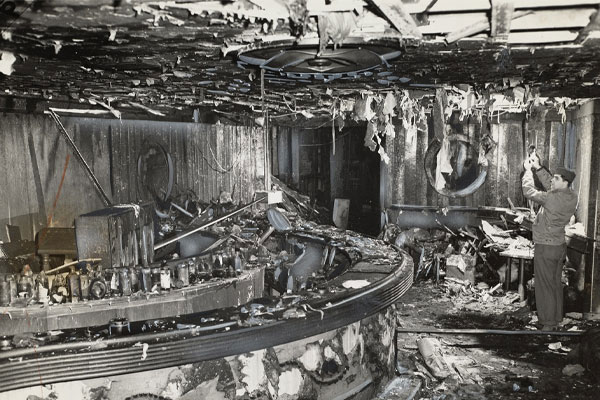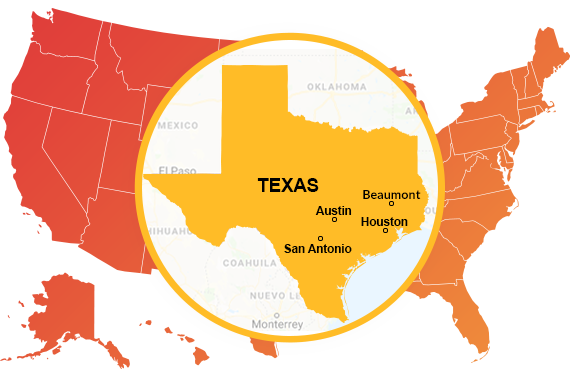Avoiding Fires: Cocoanut Grove
Part II of Robert Duval's The Legacy of Nightclub FiresIn 1942 the Cocoanut Grove nightclub was a popular destination in Boston. The club offered entertainment in a nightclub on the street level as well as more intimate surroundings in a small lounge on a lower level.
In the months leading up to the fire, another lounge (Broadway Lounge) had been opened adjacent to the club on the main level by renovating several adjacent buildings and adding them to the club's footprint. This renovation gave the facility the shape of two overlapping rectangles. The original building was constructed of concrete in 1916.
In the years prior to its transformation into a nightclub, the building was used as a garage and film storage facility. It was bordered on three sides by Piedmont Street, Shawmut Street, and Broadway. The building measured 100 ft x 90 ft (30.5 m x 27.4 m) in an irregular shape. The building was mainly a single story (with a partial lower level), except for a small upper level above the new lounge that contained dressing rooms and restrooms.
The lower level contained the Melody Lounge as well as the kitchen and liquor storage for the club. The main club area measured approximately 60 ft x 60 ft (18.3 m x 18.3 m). The Broadway Lounge measured 40 ft x 40 ft (12.2 m x 12.2 m), and the Melody Lounge measured 55 ft x 35 ft (16.8 m x 10.7 m). Exits from the facility were located on the Piedmont Street, Shawmut Street, and Broadway sides of the building. The main entrance was through a revolving door arrangement on Piedmont Street and this entrance opened into the lobby of the club. Access to the Melody Lounge was via a single set of stairs from the lobby. There were no other means of egress from this portion of the club. The Shawmut Street exit was located approximately halfway along the wall in the main club area. Another door on the Shawmut Street wall, adjacent to the stage, was locked. The Broadway exit was located in the new cocktail lounge. A single door, in the lounge, leading to the outer doors on Broadway opened inward. All other doors within the building that would have provided access to the outside were locked or obscured at the time of the fire. Another door on the wall, adjacent to the stage, was locked. The Broadway exit was located in the new cocktail lounge. A single door, in the lounge, leading to the outer doors on Broadway opened inward. All other doors within the building that would have provided access to the outside were locked or obscured at the time of the fire.


One of these locked doors was located on the Piedmont Street side, to the left of the marquee over the main entrance. Had this door been unlocked at the time of the fire, it would have provided a means of egress for the patrons in the Melody Lounge without them having to travel into the lobby and use the revolving door. Exits from the dressing rooms on the upper level were via stairs that terminated at the locked Shawmut Street door. Windows in the building were covered so as not to be visible from the inside of the building.
The interior of the nightclub was decorated with numerous fabrics and materials. These included artificial leather on walls and the bars and cloth on the ceilings. Suspended ceilings and false walls throughout the facility covered the original construction features of the building. Artificial palm trees were placed in the club and in the Melody Lounge. Lighting and the associated wiring were incorporated into these trees. The Melody Lounge also contained rattan wood wall coverings. Many of the furnishings within the club and lounges were covered in artificial leather material as well.
Reportedly, just eight days before the fire, fire department inspectors found "no flammable decorations" and sufficient exits and fire extinguishers. The only deficiency the city building inspector found in an inspection just prior to the fire was the lack of a steel fire door between the Broadway Lounge and the main dining area.
After the addition of the Broadway Lounge, the club had applied for a license as a restaurant with a capacity of 490 patrons. The reported capacity of all areas was approximately 600. On the night of November 28, 1942, the Cocoanut Grove was well over capacity, with estimates of over 1,000 occupants in the building at the time of the fire.
The fire began in the area of an artificial palm tree in the Melody Lounge. A popular account was that a busboy used a match to provide light as he investigated a faulty light bulb within the tree and within seconds, the tree had ignited. The smoke, heat, and flames spread rapidly throughout the lounge, forcing patrons to flee, using the only exit passage toward the stairs and the lobby. Many were overcome before they could reach the exit.
The first indication of trouble for occupants on the main floor was when a young woman ran screaming through the lobby with her hair on fire, immediately followed by a wave of smoke and heat from the stairwell. Many headed toward the exit on Piedmont Street, having entered the club earlier through the revolving door at that entrance. The revolving door quickly became jammed as patrons pushed toward the door.
Others within the main club headed toward the door on Shawmut Street. Many were able to exit through this door until smoke and toxic fumes, along with the tangle of hundreds of tables and chairs, overcame those remaining in the building. Those in the Broadway Lounge were the last to know of the fire, being the most remote from the lobby area.
Approximately 4 to 6 minutes from ignition, occupants from the main club area began to rush into the Broadway Lounge seeking an exit from the building. The smoke, heat, and fumes followed rapidly. The only remaining viable exit from the building was quickly jammed, as the inward-opening door was forced closed by the crush of people attempting to exit.
The fire department, which had several units on the block for an automobile fire, was alerted by a passer-by to the commotion at the Cocoanut Grove. Arriving within seconds, fire fighters immediately went to work rescuing patrons near the entrances. Additional alarms were sounded as the magnitude of the situation became apparent. Windows were broken on the Shawmut Street side in an attempt to gain access to the building and as a means of removing victims. Fire fighters and civilians began to pull bodies from the building through any accessible point. Victims, suffering burns and smoke inhalation injuries, were transported by all available means to city hospitals.
At this point, the fire had consumed the combustible interior finish and furnishings and was extinguished rapidly by the fire department. Once fire fighters were able to gain access to the interior of the building, they were met with a horrific sight: bodies piled several feet high at the revolving door and near the exit in the Broadway Lounge. Approximately 200 bodies were found at the revolving door and 100 more were found at the Broadway entrance. The remaining fatalities were found throughout the facility, many at their tables, overcome so rapidly that they were unable to make an effort to escape. In the days and weeks following the fire, the death toll became a staggering 492, making the Cocoanut Grove the deadliest nightclub fire in U.S. history. In the months following the Cocoanut Grove fire, changes were made to building codes across the country. The most notable advances were made in the areas of exits, combustible materials, emergency lighting, and automatic sprinklers. The definition of places of public assembly was also expanded.
Before the fire at the Cocoanut Grove, many jurisdictions did not consider restaurants and nightclubs to be places of public assembly. Notably, the 1942 edition of the NFPA Buildings Exit Code (the early version of today's Life Safety Code) did consider nightclubs to be essentially places of public assembly, in the same class as a theatre, but having a greater possibility of fire. Today, it is recognized that all assembly occupancies should have at least two separate and remote means of egress, and the necessary number, width, and types of reliable exits based on the expected occupancy should be available.
After the fire, Robert Moulton, NFPA's Technical Secretary and the secretary of the NFPA Committee on Safety to Life, indicated in a newspaper interview: "The most glaring feature of this tragedy was the lack of proper exits. Revolving doors have long been considered by the National Fire Protection Association Committee on Safety to Life as a menace under fire and panic conditions. "That same edition of the Code required that "decorations of theatres and assembly halls shall be of fire-resistive or nonflammable materials. Fabrics and papers used for such purposes shall be treated with an effective flame-proofing material." A cautionary note warned: "Paper and cloth decorative materials should be kept to a minimum in places of assembly since such flimsy materials increase the hazard of the kindling and spread of fire."
Largely as a direct result of the Cocoanut Grove fire, the Building Exits Code was adopted by many more jurisdictions across the country, due in large part to the efforts of the fire service. The Committee on Safety to Life reported on that increased usage at the 1945 NFPA Annual Meeting. It was during the 1945 NFPA Annual Meeting that the Committee on Safety to Life also recommended a change in the method of exit measurement, clarification of the need for stairway enclosure, provisions regulating loose chairs in nightclubs, and changes in lighting and signs. Those changes were incorporated into the 1946 edition of the Code, as was a special note on interior finish.
- Aldine
- Alvin
- Ames
- Anahuac
- Angleton
- Arcola
- Atascocita
- Austin
- Bacliff
- Bailey Prairie
- Barker
- Barrett
- Bay City
- Bayou Vista
- Baytown
- Beach City
- Beasley
- Beaumont
- Bellaire
- Boling
- Bonney
- Brazoria
- Brazos Country
- Brookshire
- Brookside Village
- Bunker Hill Village
- Cedar Park
- Channelview
- Cinco Ranch
- Clear Lake Shores
- Cleveland
- Cloverleaf
- Clute
- Conroe
- Corsicana
- Cove
- Crosby
- Cumings
- Cut And Shoot
- Cypress
- Damon
- Danbury
- Dayton
- Dayton Lakes
- Deer Park
- Dickinson
- East Bernard
- El Lago
- Fairchilds
- Fifth Street
- Fort Bend
- Four Corners
- Freeport
- Fresno
- Friendswood
- Fulshear
- Galena Park
- Galveston
- Grand Prairie
- Greatwood
- Guy
- Hardin
- Harris
- Hedwig Village
- Hempstead
- Highlands
- Hillcrest
- Hilshire Village
- Hitchcock
- Hockley
- Holiday Lakes
- Houston
- Huffman
- Hufsmith
- Humble
- Hungerford
- Hunters Creek Village
- Huntsville
- Iago
- Iowa Colony
- Jacinto City
- Jamaica Beach
- Jersey Village
- Katy
- Kemah
- Kendleton
- Kenefick
- Kingwood
- La Marque
- La Porte
- Lake Jackson
- League City
- Liberty
- Liverpool
- Livingston
- Lorena
- Magnolia
- Manor
- Manvel
- Meadows Place
- Mission Bend
- Missouri City
- Mont Belvieu
- Montgomery
- Morgans Point
- Nassau Bay
- Navasota
- Needville
- New Territory
- North Cleveland
- North Houston
- Oak Island
- Oak Ridge North
- Old River-Winfree
- Orange
- Orchard
- Panorama Village
- Pasadena
- Pattison
- Patton Village
- Pearland
- Pecan Grove
- Pine Island
- Pinehurst CDP
- Piney Point Village
- Pleak
- Plum Grove
- Port Arthur
- Porter
- Porter Heights
- Prairie View
- Richardson
- Richmond
- Richwood
- Roman Forest
- Rosenberg
- Rosharon
- Sabine Pass
- San Antonio
- San Felipe
- San Leon
- Santa Fe
- Seabrook
- Sealy
- Seguin
- Sheldon
- Shenandoah
- Shoreacres
- Silsbee
- Simonton
- South Houston
- Southside Place
- Splendora
- Spring
- Stafford
- Stagecoach
- Sugar Land
- Taylor Lake Village
- Texas City
- The Woodlands
- Thompsons Alief
- Tiki Island
- Todd Mission
- Tomball
- Waller
- Wallis
- Webster
- West Columbia
- West University Place
- Weston Lakes
- Willis
- Woodbranch
- Woodloch


